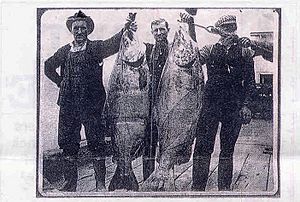June hogs facts for kids
June hogs were giant Chinook salmon that used to swim in the rivers of the Pacific Northwest in the United States. These amazing fish were caught mostly in the summer. They were huge, sometimes weighing as much as 80 pounds (36 kg)! That's like a small person!

Contents
What Were June Hogs?
June hogs got their name because they appeared in "runs" (when many fish swim together) during the month of June. The "hog" part of their name came from their enormous size. They were much bigger than the Chinook salmon we see today. Today's largest Chinook salmon are only about half the size of these old giants.
Super-Salmon of the Rivers
People called June hogs "supersalmon" because they were so strong and special. These powerful fish could swim over 1,000 miles (1,600 km) up the Columbia River and even into Canada. They had huge amounts of energy stored up, which helped them make these long journeys.
Life Cycle and Reproduction
June hogs were also known for producing many offspring (baby fish). This helped keep their populations strong. Experts believe that these special Chinook salmon probably went to the ocean when they were very young, even before they were one year old. This early start might have helped them grow so big and strong.
Who Caught June Hogs?
For many years, June hogs were caught regularly each summer.
- First Nations peoples: These are the original inhabitants of Canada, similar to Native American tribes in the U.S. They have a long history of fishing for salmon.
- Sportfishers: These are people who fish for fun.
- Salmon canneries: These were factories that processed and canned salmon to sell. Many canneries operated on the Columbia River and its smaller rivers.
Why Did June Hogs Disappear?
Sadly, June hogs have now disappeared. This happened because the number of salmon in general has gone down a lot. Many things have caused this decline, including changes to their river homes and too much fishing in the past. The disappearance of June hogs shows us how important it is to protect our rivers and the amazing fish that live in them.

